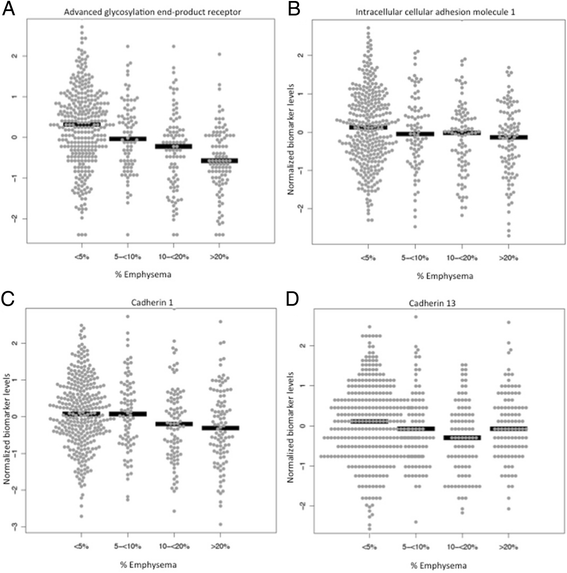The association of plasma biomarkers with computed tomography-assessed emphysema phenotypes
- PMID: 25306249
- PMCID: PMC4198701
- DOI: 10.1186/s12931-014-0127-9
The association of plasma biomarkers with computed tomography-assessed emphysema phenotypes
Abstract
Rationale: Chronic obstructive pulmonary disease (COPD) is a phenotypically heterogeneous disease. In COPD, the presence of emphysema is associated with increased mortality and risk of lung cancer. High resolution computed tomography (HRCT) scans are useful in quantifying emphysema but are associated with radiation exposure and high incidence of false positive findings (i.e., nodules). Using a comprehensive biomarker panel, we sought to determine if there was a peripheral blood biomarker signature of emphysema.
Methods: 114 plasma biomarkers were measured using a custom assay in 588 individuals enrolled in the COPDGene study. Quantitative emphysema measurements included percent low lung attenuation (%LAA) ≤ -950 HU, ≤ - 910 HU and mean lung attenuation at the 15th percentile on lung attenuation curve (LP15A). Multiple regression analysis was performed to determine plasma biomarkers associated with emphysema independent of covariates age, gender, smoking status, body mass index and FEV1. The findings were subsequently validated using baseline blood samples from a separate cohort of 388 subjects enrolled in the Treatment of Emphysema with a Selective Retinoid Agonist (TESRA) study.
Results: Regression analysis identified multiple biomarkers associated with CT-assessed emphysema in COPDGene, including advanced glycosylation end-products receptor (AGER or RAGE, p < 0.001), intercellular adhesion molecule 1 (ICAM, p < 0.001), and chemokine ligand 20 (CCL20, p < 0.001). Validation in the TESRA cohort revealed significant associations with RAGE, ICAM1, and CCL20 with radiologic emphysema (p < 0.001 after meta-analysis). Other biomarkers that were associated with emphysema include CDH1, CDH 13 and SERPINA7, but were not available for validation in the TESRA study. Receiver operating characteristics analysis demonstrated a benefit of adding a biomarker panel to clinical covariates for detecting emphysema, especially in those without severe airflow limitation (AUC 0.85).
Conclusions: Our findings, suggest that a panel of blood biomarkers including sRAGE, ICAM1 and CCL20 may serve as a useful surrogate measure of emphysema, and when combined with clinical covariates, may be useful clinically in predicting the presence of emphysema compared to just using covariates alone, especially in those with less severe COPD. Ultimately biomarkers may shed light on disease pathogenesis, providing targets for new treatments.
Figures

References
-
- Vestbo J, Hurd SS, Agusti AG, Jones PW, Vogelmeier C, Anzueto A, Barnes PJ, Fabbri LM, Martinez FJ, Nishimura M, Stockley RA, Sin DD, Rodriguez-Roisin R. Global strategy for the diagnosis, management, and prevention of chronic obstructive pulmonary disease: GOLD executive summary. Am J Respir Crit Care Med. 2013;187(4):347–365. doi: 10.1164/rccm.201204-0596PP. - DOI - PubMed
-
- Fletcher CM, Gilson JG, Hugh-Jones P, Scadding JG. Terminology, definitions, and classification of chronic pulmonary emphysema and related conditions. Thorax. 1959;14:286–299. doi: 10.1136/thx.14.4.286. - DOI
-
- Li Y, Swensen SJ, Karabekmez LG, Marks RS, Stoddard SM, Jiang R, Worra JB, Zhang F, Midthun DE, de Andrade M, Song Y, Yang P. Effect of emphysema on lung cancer risk in smokers: a computed tomography-based assessment. Cancer Prev Res (Phila) 2011;4(1):43–50. doi: 10.1158/1940-6207.CAPR-10-0151. - DOI - PMC - PubMed
-
- de Torres JP, Bastarrika G, Wisnivesky JP, Alcaide AB, Campo A, Seijo LM, Pueyo JC, Villanueva A, Lozano MD, Montes U, Montuenga L, Zulueta JJ. Assessing the relationship between lung cancer risk and emphysema detected on low-dose CT of the chest. Chest. 2007;132(6):1932–1938. doi: 10.1378/chest.07-1490. - DOI - PubMed
Publication types
MeSH terms
Substances
Grants and funding
LinkOut - more resources
Full Text Sources
Other Literature Sources
Medical
Miscellaneous

